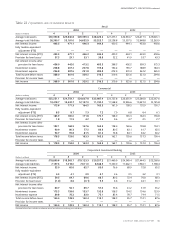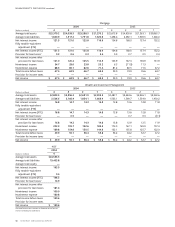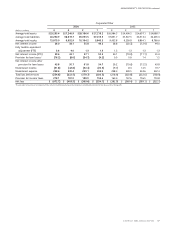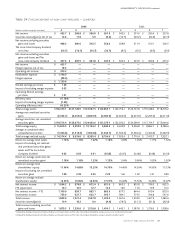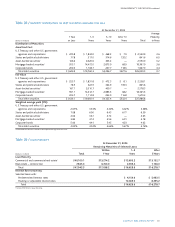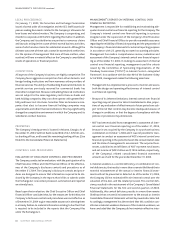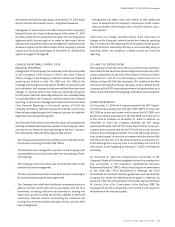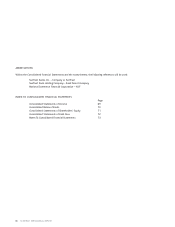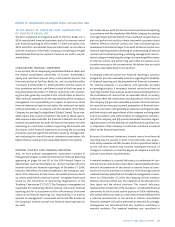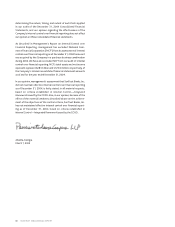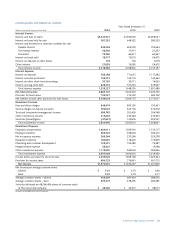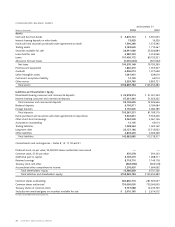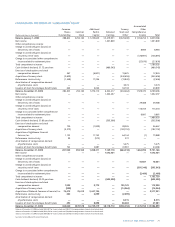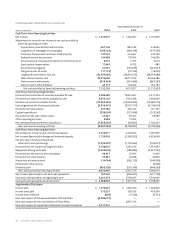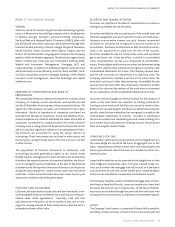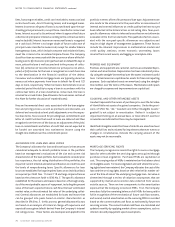SunTrust 2004 Annual Report Download - page 66
Download and view the complete annual report
Please find page 66 of the 2004 SunTrust annual report below. You can navigate through the pages in the report by either clicking on the pages listed below, or by using the keyword search tool below to find specific information within the annual report.
64 SUNTRUST 2004 ANNUAL REPORT
MANAGEMENT’S DISCUSSION continued
LEGAL PROCEEDINGS
On January 11, 2005, the Securities and Exchange Commission
issued a formal order of investigation and the SEC Staff issued sub-
poenas seeking documents related to the Company’s allowance for
loan losses and related matters.The Company is cooperating, and
intends to cooperate with the SEC regarding this matter.In addition,
the Company and its subsidiaries are parties to numerous claims
and lawsuits arising in the course of their normal business activities,
some of which involve claims for substantial amounts.Although the
ultimate outcome of these suits cannot be ascertained at this time,
it is the opinion of management that none of these matters, when
resolved, will have a material effect on the Company’s consolidated
results of operations or financial position.
COMPETITION
All aspects of the Company’s business are highly competitive.The
Company faces aggressive competition from other domestic and
foreign lending institutions and from numerous other providers of
financial services.The ability of nonbanking financial institutions to
provide services previously reserved for commercial banks has
intensified competition. Because nonbanking financial institutions
are not subject to the same regulatory restrictions as banks and
bank holding companies, they can often operate with greater flexi-
bility and lower cost structures. Securities firms and insurance com-
panies that elect to become financial holding companies may
acquire banks and other financial institutions.This may significantly
change the competitive environment in which the Company and its
subsidiaries conduct business.
PROPERTIES
The Company’s headquarters is located in Atlanta, Georgia.As of
December 31, 2004, SunTrust Bank owned 832 of its 1,676 full-serv-
ice banking offices, and leased the remaining banking offices. (See
Note 8 to the Consolidated Financial Statements.)
CONTROLS AND PROCEDURES
EVALUATION OF DISCLOSURE CONTROLS AND PROCEDURES
The Company conducted an evaluation, with the participation of its
Chief Executive Officer and Chief Financial Officer, of the effective-
ness of the Company’s disclosure controls and procedures as of
December 31, 2004.The Company’s disclosure controls and proce-
dures are designed to ensure that information required to be dis-
closed by the Company in the reports that it files or submits under
the Exchange Act is recorded, processed, summarized and reported
on a timely basis.
Based upon that evaluation, the Chief Executive Officer and Chief
Financial Officer concluded that, for the reasons set forth below, the
Company’s disclosure controls and procedures were not effective as
of December 31, 2004 to give reasonable assurance in alerting them
in a timely fashion to material information relating to SunTrust that
is required to be included in the reports that the Company files
under the Exchange Act.
MANAGEMENT’S REPORT ON INTERNAL CONTROL OVER
FINANCIAL REPORTING
Management is responsible for establishing and maintaining ade-
quate internal control over financial reporting for the Company.The
Company’s internal control over financial reporting is a process
designed under the supervision of the Company’s Chief Executive
Officer and Chief Financial Officer to provide reasonable assurance
regarding the reliability of financial reporting and the preparation of
the Company’s financial statements for external reporting purposes
in accordance with U.S. generally accepted accounting principles.
Management has made a comprehensive review, evaluation and
assessment of the Company’s internal control over financial report-
ing as of December 31, 2004. In making its assessment of internal
control over financial reporting, management used the criteria
issued by the Committee of Sponsoring Organizations of the
Treadway Commission (“COSO”) in Internal Control—Integrated
Framework. In accordance with Section 404 of the Sarbanes-Oxley
Act of 2002, management makes the following assertions:
• Management has implemented a process to monitor and assess
both the design and operating effectiveness of internal control
over financial reporting.
• Because of its inherent limitations, internal control over financial
reporting may not prevent or detect misstatements.Also, projec-
tions of any evaluation of effectiveness to future periods are sub-
ject to the risk that controls may become inadequate because of
changes in conditions, or that the degree of compliance with the
policies or procedures may deteriorate.
• NCF has been excluded from management’s assessment of inter-
nal control over financial reporting as of December 31, 2004,
because it was acquired by the Company in a purchase business
combination on October 1, 2004 and it was not possible for man-
agement to conduct an assessment of NCF’s internal control over
financial reporting in the period between the consummation date
and the date of management’s assessment. The acquired busi-
nesses, subsidiaries and affiliates of NCF represent total assets
and net income of $28.5 billion and $120.6 million, respectively,
of the Company’s related consolidated financial statement
amounts as of and for the year ended December 31, 2004.
A material weakness is a control deficiency, or combination of con-
trol deficiencies, that results in more than a remote likelihood that a
material misstatement of the annual or interim financial state-
ments will not be prevented or detected.As of December 31, 2004,
the Company did not maintain effective internal control over the
valuation of the ALLL and the related provision.This control defi-
ciency resulted in the restatement of the Company’s Consolidated
Financial Statements for the first and second quarters of 2004.
Additionally, this control deficiency results in a more than remote
likelihood that a material misstatement to the annual or interim
Consolidated Financial Statements will not be prevented or detected.
Accordingly, management has determined that this condition con-
stitutes a material weakness. Because of this material weakness, we
have concluded that the Company did not maintain effective inter-



